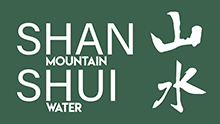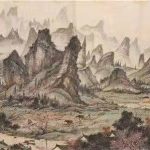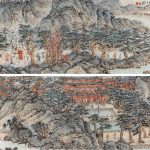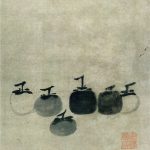Contemporary Tradition – inherit and transmit
Issue 3 – By; Giacomo Bruni
The development of Chinese mountain and water painting shanshui hua 山水画 naturally follows the historical and cultural evolution of China. The formation of the artistic style, genre, and language of the past dynasties of mountain and water painting was not accomplished overnight, it was inherited and developed gradually drawing on the artistic experience of predecessors and gradually forming through a long period of brush and ink practice. Every change has been inextricably linked with the predecessors, but also influences the future generations. It is an endless process. People expand in retrospect, repetitively review the old and learn the new, so the Chinese mountain and water painting is constantly enriched, developed and improved.
Shanshui hua has a long history, it is a complete system with a highly clear context.. It has provided us with incredibly rich learning resources for the teaching of mountain and water painting. From the practice of brush and ink, the cognition of theoretics, to the final completeness of both form and spirit. A rigorous style of study, meditation, and spiritual comprehension are required and goes hand in hand with equal emphasis on academic theory.
It is particularly important to cultivate artistic abilities with moral sentiment, an intellectual character, artistic spirit and brush and ink skills, to build a self-worthy system with contemporary spirit and an independent personality. Chinese mountain and water painting is based on the humanistic value orientation. When we face the traditional classics and look up the mountains, we perceive the creative ideas of Shanshui hua, and at the same time it contains a profound humanistic affection to borrowing things. The brush-and-ink language of expressing ideas and writing mental images enables the noumenon and creativity of art to extend, and thus creates a dialogue with the world, with an open heart and mind (xin 心), as brush and ink are things with flesh, blood and vitality.
Tradition chuntong 传统 can both “pass” 传 and “unify” 统, and endure for thousands of years. Of course, tradition cannot have the same face. Tradition is the indelible essence that has gone through the years. It has strong tolerance and continuity. In the vast and fertile soil of tradition, generations of mountain and water painters have been nurtured, and many artistic monuments have been erected. Tradition is worthy of our constant learning, reference and growth. The teaching of shanshui hua is inseparable from the process of mastering the ancients, and with a daring heart, through reproduction, sketching, creation, calligraphy, seal cutting, poetry inscriptions, and painting theory etc, its comprehensive learning is improved, and systematic training and research are carried out. The cultivation of all levels of learning, movement skills and enlightenment is carried out step by step, and they are continuously digested, consolidated and promoted until the moral cultivation and artistic characters are gradually perfected. Dao 道, the way, consists of techniques and virtue, the two complement each other. If we are unwitting of the methods or unable to master the skills, we will lack the ability to control brush and ink .The artistic transformation of shanshui hua goes from the state of brush and ink, to the state of humanities, and then to the state of life; including ancient and modern, indigenous and foreign, pioneering and innovating, by constructing the ontological spirit and independent personality, building a solid foundation with deep accumulation, and fully stimulating the potential creativity, these are the first priorities when walking the path of mountain and water painting.
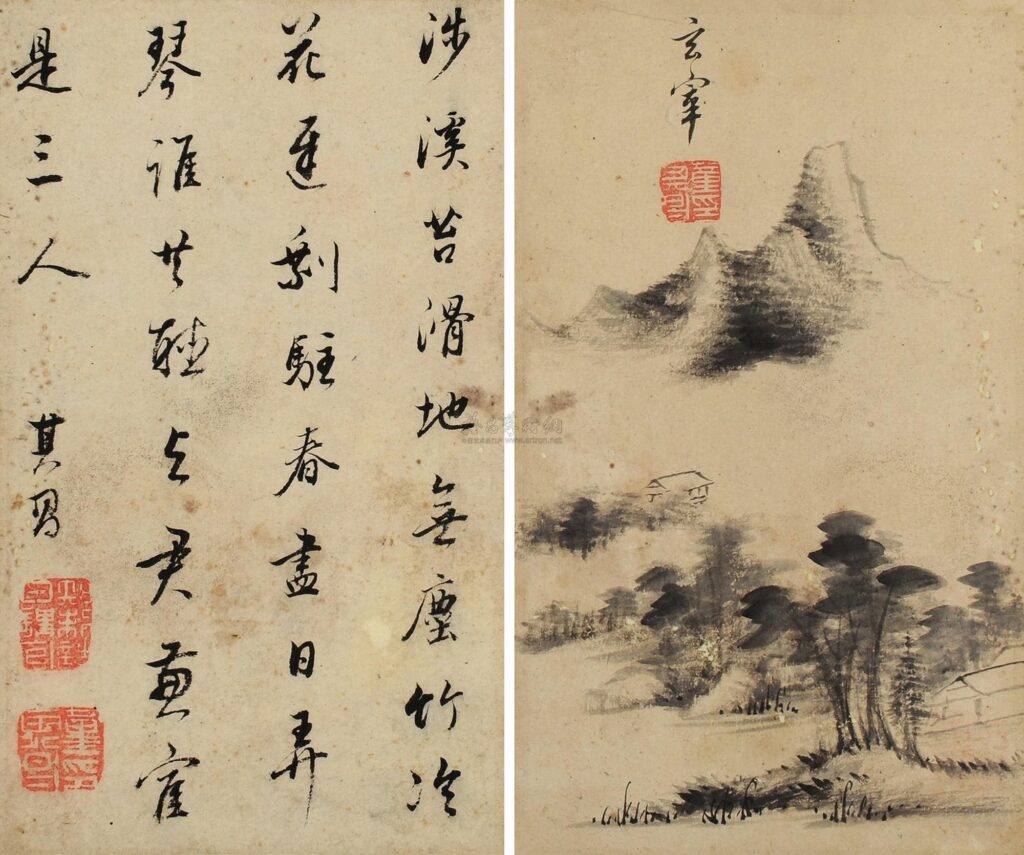
Understanding the relationship between the physics perception and brushwork skills of mountain and water painting – the wind, snow, rain and sun, the cold and warm of the day and night, the ever-changing heights and lows of the natural world, is to understand the variation of mountains, mists, the thickness of the woods, and the human presence in the environment. The concealment, the rapidness of the spring, the twists and turns of the road, and the expressions of the academic theory and understanding it in the language of the brush and ink, such as intensity, gentleness, severity, mildness, opening and closing, density, lushness, and gathering starts with mastering the techniques and improving the overall cultivation, to fully stimulate the creative talent under the self-consciousness.
Throughout the development of the teaching of mountain and water painting, traditional classics and old generation art educators have accumulated a large number of sketches, technical drawing books, research literature, and theoretical readings for us. They devoted their entire lives to these teachings. These painstaking efforts have become the permanent treasure of teaching today’s mountain and water painting. Throughout the ages, outstanding artists and drawings of educators have been a model to our learning. The joint efforts of mountain and water painters, the unity of knowledge and action, and innovations have created a new paradigm for the development of mountain and water painting in the new era. Whether by borrowing the inheritance of the past and the present, the compatibility of Chinese and Western integration, or the innovation of seeking novelty and difference, they are all exploration and practice around the grand pattern of shanshui hua. Unique artistic insights, novel formal language, and rich accumulation of brush and ink, together to builds a broad intellectual vision and profound humanistic knowledge of contemporary mountain and water paintings has become a powerful driving force for diversified development.
This vast amount of material is of great importance and usefulness, also considering the fact that the pictorial and calligraphic materials: paper or silk, brush and ink have basically remained the same, therefore the techniques and practices developed from antiquity to the present day are always applicable and can always be a source of inspiration. The same applies to the theoretical treatises that discuss the use of brush and ink. Texts written a thousand or more years ago contain ideas and teachings perfectly applicable to contemporary painting practice. The speculations on the use of the brush, the various techniques created and used by the artists of the past can be resumed and modified, developed and adapted to the artistic needs of the artists of subsequent eras and these would be modified again by their successors. This type of relationship between tradition and creation (in the artist’s contemporaneity), has led to an uninterrupted evolutionary flow of artistic practice for two millennia. During the different historical periods, the evolution of painting techniques has been more or less fruitful, but even in the less creative moments more linked to academic formality and a more submissive approach to tradition, there has always been great figures of artists and intellectuals who raised their voices to counter the submission and lack of creativity of their contemporaries.
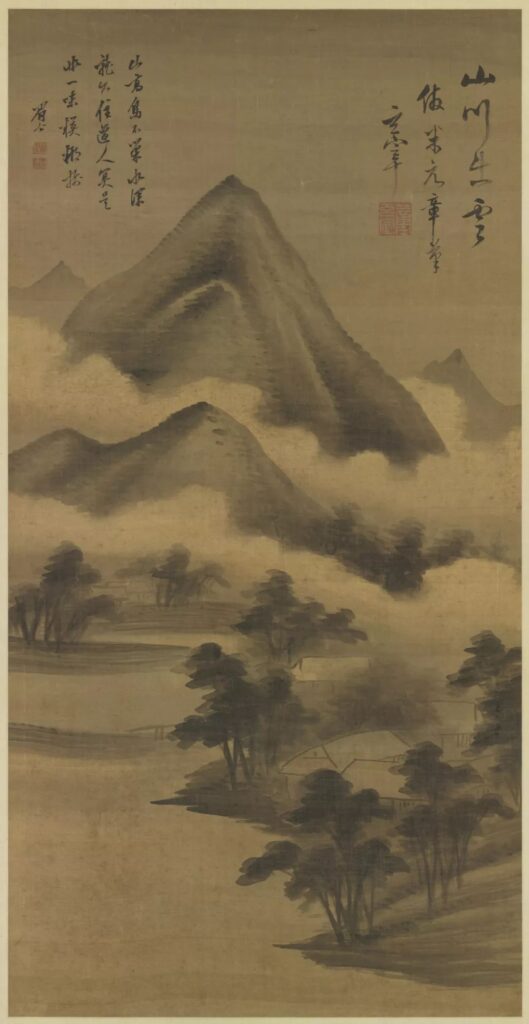
The relationship with tradition is not passive, much less submissive, the artists and intellectuals of the past are innumerable, the choice of masters to refer to is up to the contemporary and to the individual, not necessarily everything that is tradition is good, high level or suited to the needs of the artist, it is necessary to establish a form of dialogue with the past, to know it, to understand it and to grasp the teachings necessary for self-cultivation and evolution.
Tradition is not like what the historical avant-gardes have made us believe, a burden that we carry and something that crushes our creativity. In the vision of Chinese artistic training, tradition is the support, the basis and the foundation that raises our creativity, since it provides the means for its expression. The tradition, being constantly updated by the intellectual artists, is increasingly rich in means. It is a theoretical and technical support that leads creativity to go beyond these teachings, not through a process of destruction and cancellation of the past that would bring the evolution back to the initial level, and therefore having to reinvent something new. At the same time we cannot limit ourselves to mere copying and theft, it is necessary to go through a process of self-enrichment that would lead to manage how you use and enrich traditional means in order to express the needs of contemporaneity. One of the fundamental axioms of art is that art is life, if it ends with academicism it is only a virtuous or erudite game, a technical and intellectual practice for its own sake, which will hardly move the souls of those who come into contact with it.
Through inheritance and transmission, each subsequent generation is potentially in a richer situation than the previous one, but the field can be expanded even more if we take into consideration the traditions different from ours, which developed following different paths, but always generated by the humans occupying this planet. Different traditions with different evolution naturally lead to different systems of thoughts and values, different artistic expressions etc., but in some way they all respond to problems or express the spirit of human beings. Only those who will be able to look at traditions with their own view, study, understand and not dedicate themselves to mere collage, will find themselves in a situation much richer and potentially more stimulating, as they are enriched by new and different interpretations and elaborations of the world.
Naturally it is not enough to know the foreign or the past, but a sensitivity from the artist’s side is needed for him to understand and enrich himself; copying, theft, borrowing, leads only to empty shells that are not even worth considering. Only those who are inspired can create something new and valuable, something that gives broader answers or asks questions never asked. In these terms, the tradition or traditions have great value for the evolution of the arts, of man, and of the world.
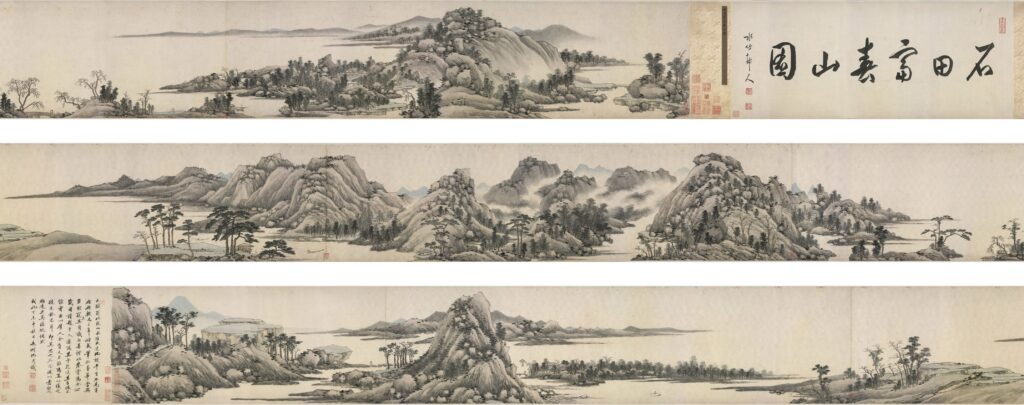
Shen Zhou 沈周 (1427-1509) Lofty Mount Lu, Lushan gao tu《庐山高图》
Shen Zhou’s landscape paintings uses the unique vigor of the northern style to express the beauty and the charm of the southern landscape, so that the north and south styles are organically integrated, and they benefit and complement each other.
Lofty Mount Lu, is of special significance. In the painting there are lofty mountains and ridges, which recalls Wang Meng’s 王蒙 (1308-1385) brushwork and structure, depicting dangerous peaks, tall pine and giant trees, with majestic and magnificent mountains. The whole brush and ink look solid and vigorous, the scenery is lush and magnificent. Shen Zhou follows the way of the brushwork of Wang Meng, even though he is more fresh and ethereal. It integrates the “noble” artistic character ideal with the magnificent nature, in order to reveal the painter’s mind.
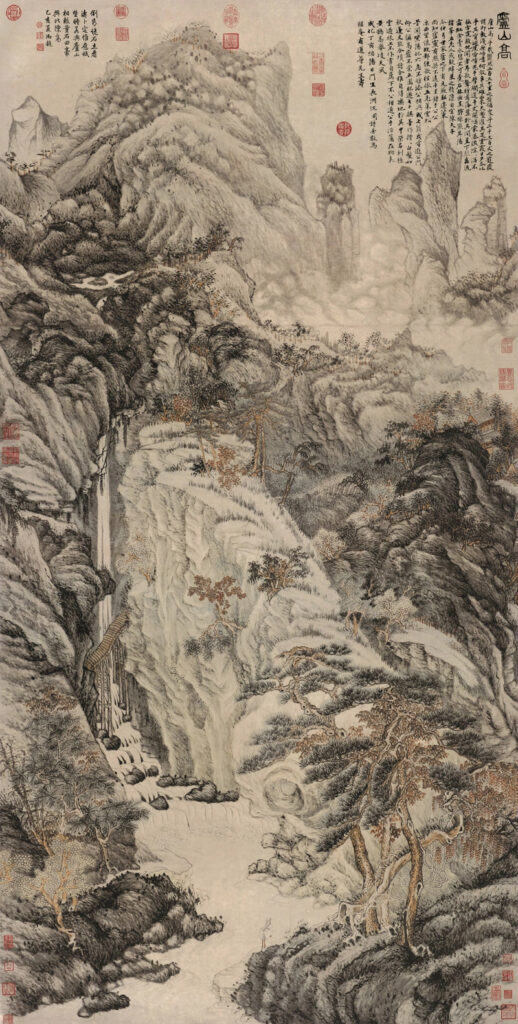
The brushwork of the mountains, stones, forests and trees in the painting are all imitated by Wang Meng, benefiting from his own skill, it feels more primitive and vigorous. The mountains and stones are fused with Wang Meng’s texture methods: ravelled ropes jiesuo cun 解索皴 and ox hair niumao cun 牛毛皴 texture methods. The mountains and slopes were first modeled with hemp-fiber texture pima cun 披麻皴 strokes and tinted with light ink, to which layers of dark ink were added to build up the slopes. The mists and the colouring of the mountains are particularly luminous.

Lofty Mount Lu mainly draws on the essence of Wang Meng’s brushwork and expresses the vigorous atmosphere of the famous mountain. The layout of the whole painting is full of charm, the setting is lofty and profound, meticulous and complicated. Throughout the whole picture, although it is mainly light colors, the wonderful effects of the five colors of ink, charred jiao 焦, concentrated nong 浓, light dan 淡, wet shi 湿 and dry gan 干, have been shown in full.
This painting clearly recalls to Wang Meng techniques, is a clear example of how a post generation artist looks at tradition, makes it his own, reinterprets it and proposes it again, directly paying homage to a master of the past with a great work.
Picasso (1881-1973) and African Art
A smell of mould and neglect caught me by the throat. I was so depressed that I would have chosen to leave immediately. But I forced myself to stay, to examine these masks, all these objects that people had created with a sacred, magical purpose, to serve as intermediaries between them and the unknown, hostile forces surrounding them, attempting in that way to overcome their fears by giving them colour and form. And then I understood what painting really meant. It’s not an aesthetic process; it’s a form of magic that interposes itself between us and the hostile universe, a means of seizing power by imposing a form on our terrors as well as on our desires. The day I understood that, I had found my path.
Picasso is one of the most celebrated examples of artists influenced by traditions outside his own.
In the spring of 1907, Picasso was visiting Gertrude Stein, the famous American writer, when Henry Matisse also visited him with an African sculpture he had just bought. Picasso was fascinated by the shape of the human figure in that sculpture.
A few days after visiting Gertrude Stein, Picasso went to the Trocadero Ethnological Museum, now Musée de l’Homme, with his friend André Derain. Picasso later stated that this visit was crucial for his training as an artist. This was the beginning of the important “black period” and in a certain sense also of Cubism, in fact what is traditionally considered Picasso’s first Cubist work, Les Demoiselles d’Avignon (1907), bears the sign of the influence of ‘African art, it shows the deformation of the faces that assume an angular and geometric shape, remarkably similar to some African masks.
Picasso was not the only one to visit the exhibition or to come into contact with African art, only he painted Les Demoiselles d’Avignon. During that time, only he (and Matisse) had the sensitivity to be influenced and grasp a new vision.
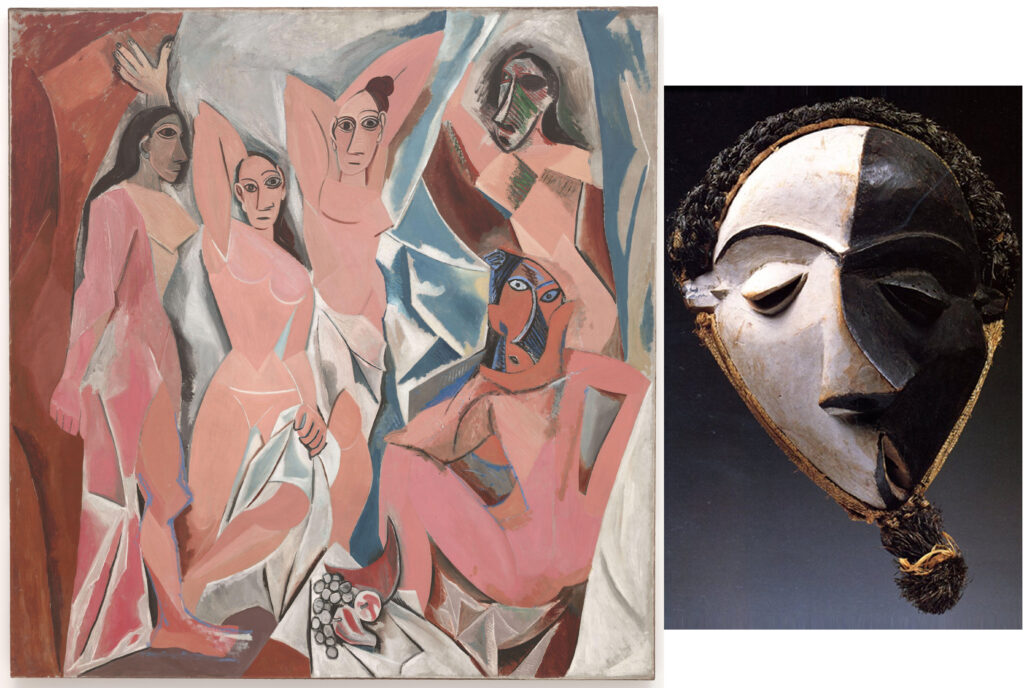
Read the full magazine
